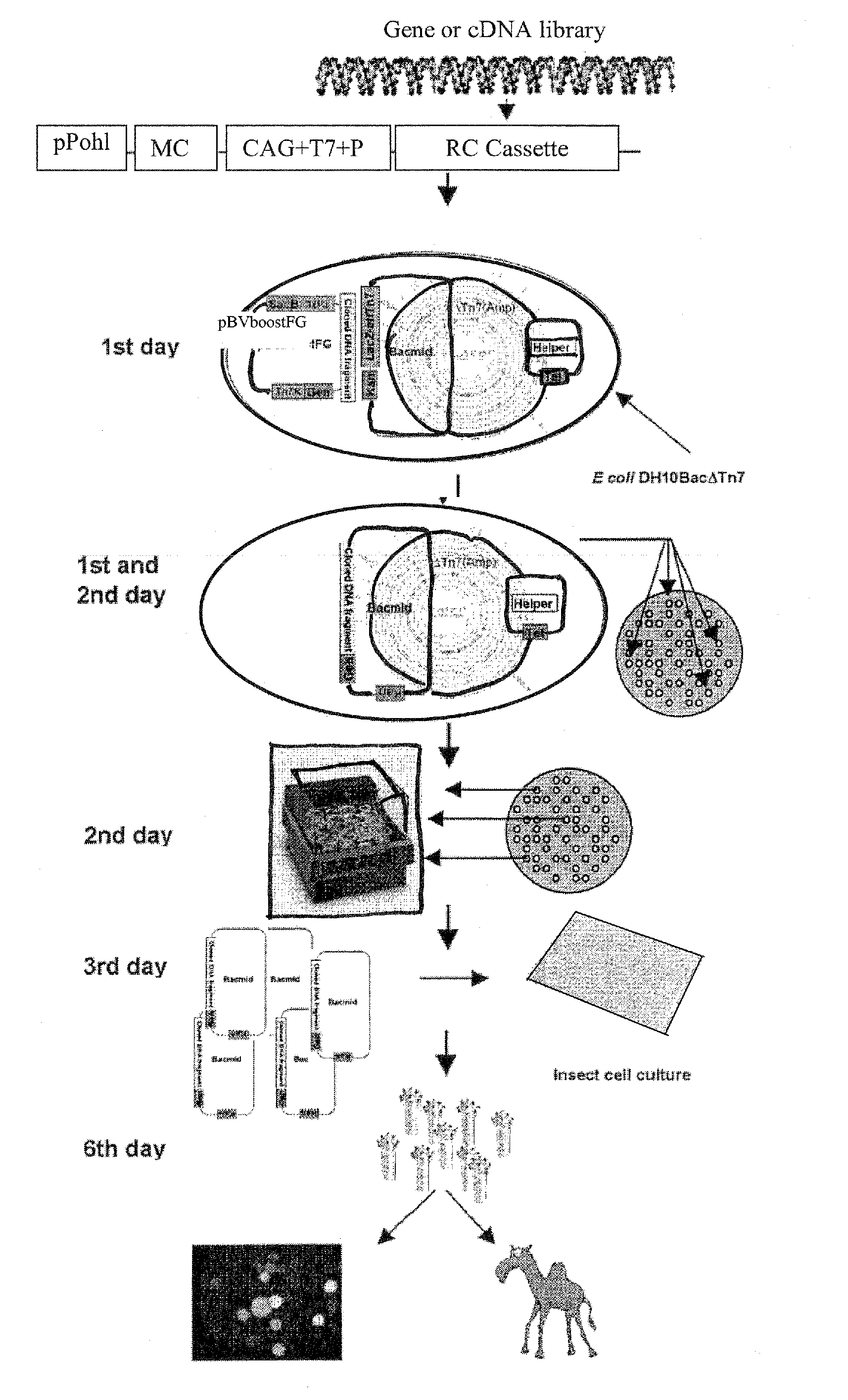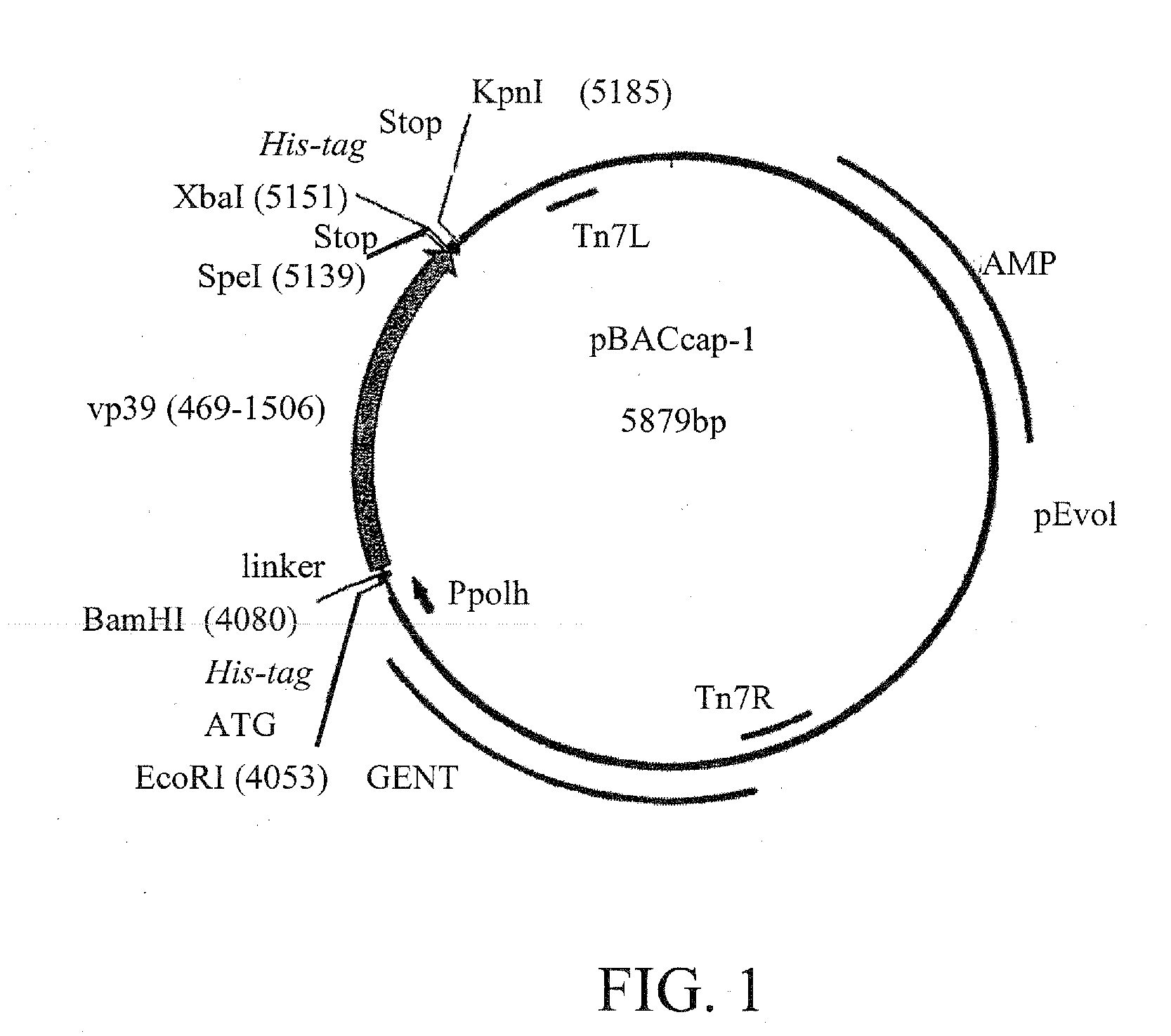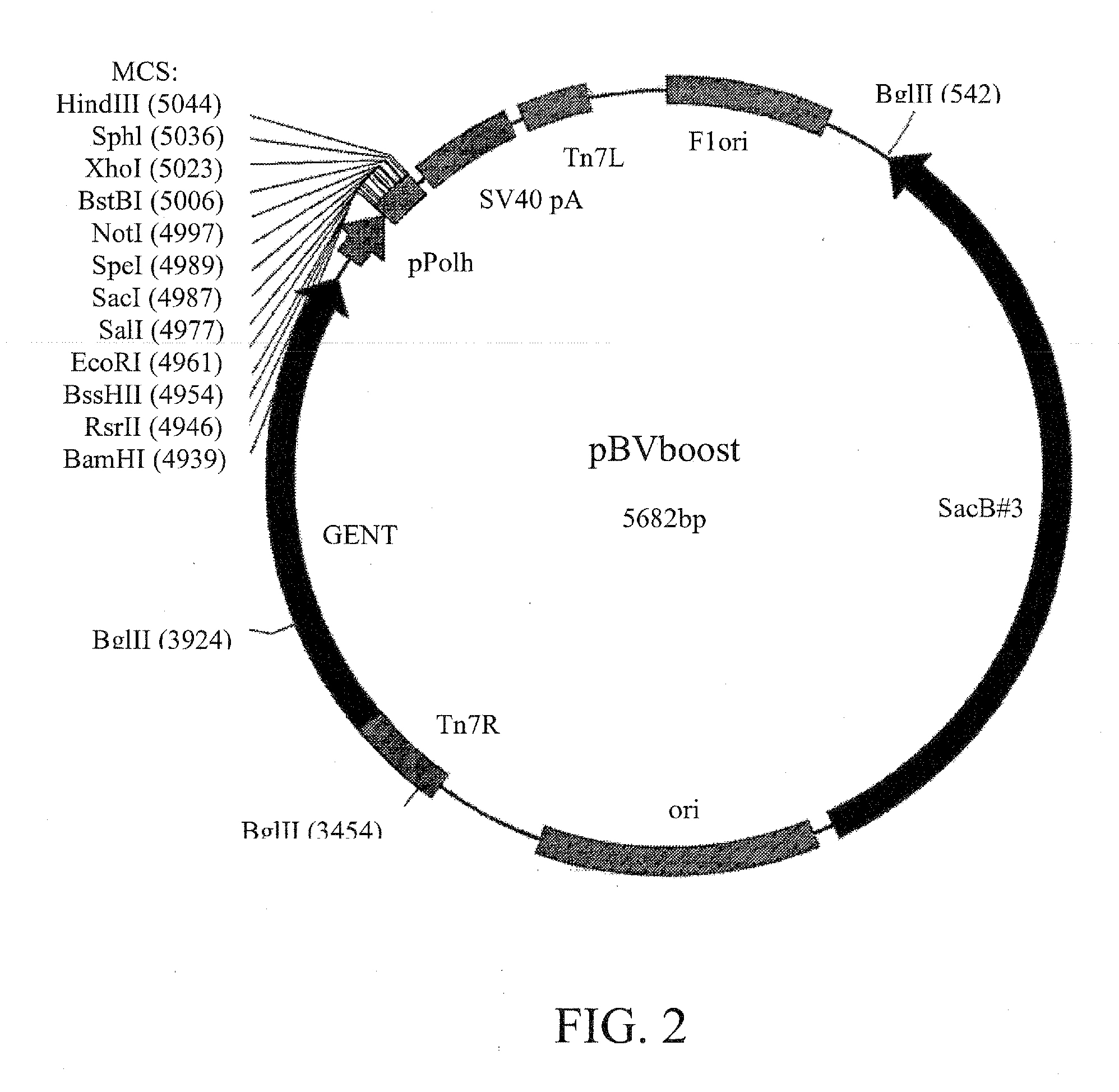Engineered Baculoviruses and Their Use
a technology of baculoviruses and baculoviruses, applied in the field of engineered baculoviruses, can solve the problems of large and complex virion, low phenotypic value of plasmid libraries, and inability to explain all the genes in sequence information as such, so as to improve the display of complex peptides and proteins, easy and fast production, and easy and effective cloning
- Summary
- Abstract
- Description
- Claims
- Application Information
AI Technical Summary
Benefits of technology
Problems solved by technology
Method used
Image
Examples
example 1
Capsid Display Vector—vp39
[0066]In order to construct a general baculovirus vector for capsid display, the region corresponding to nucleotides (nt) 469-1506 of vp 39 (Genbank:M22978) was amplified from the purified bacmid DNA (Luckow et al, J. Virol. 67, 4566-4579, 1993) by polymerase chain reaction (PCR). The forward primer was 5′-TT GAA AGA TCTGAA TTC ATG CAC CAC CAT CAC CAT CAC GGA TCC GGC GGC GGC GGC TCG GCG GCT AGT GCC CGT GGG T -3′ (specific sequence for nt 469-486 of vp39 gene in bold; BglII, EcoRI, BamHI, sites underlined; 6× Histidine tag with start codon in italics); the reverse primer was 5′-TT CTG GGT ACC GCt tta ATG GTG ATG ATG GTG GTG TCT AGA GCt tta ACT AGT GAC GGC TAT TCC TCC ACC -3′ (specific sequence for nt 1489-1506 of vp39 gene in bold; KpnI, XbaI and SpeI sites underlined; 6× Histidine tag in italics; stop codon in small caps). PCR was performed essentially as described by Airenne et al, Gene 144:75-80, 1994, except annealing was set to 58° C. Amplified fragment...
example 2
Bacterial Strains, Plasmids, Cell Lines and Viral DNA
[0080]E. coli strain DH5α (Invitrogen, USA) was used for propagation of plasmids. DH10Bac cells and pFastbac1 were obtained from Invitrogen. pDNR-LIB vector containing SacB gene was purchased from BD Biosciences Clontech, USA.
Construction of Modified Donor Vector
[0081]The modified donor vector was constructed by replacing the Ampicillin resistance gene in pFastbac1 vector with Bacillus subtilis levansucrase gene (SacB) from pDNR-LIB vector. In practice, pFastbac1 vector was cut by BspHI restriction enzyme, and the linear vector backbone was purified by gel electrophoresis. The SacB expression cassette was obtained from pDNR-LIB by polymerase chain reaction (PCR) with the primers DNR5′: 5′-GTTATTCATGAGATCTGTCAATGCCAATAGGATATC-3′ (sequence for nt 1263-1282 of pDNR-LIB in bold; BspHI and BglII sites underlined), DNR3′: 5′-TTAGGTCATGAACATATACCTGCCGTTCACT-3′ (sequence for nt 3149-3179 of pDNR-LIB in bold; BspHI site underlined). PCR wa...
example 3
Construction of pBVboostFG and pBVboostFGR
[0087]In order to allow recombinational cloning into planned vector, the Gateway cloning cassette A (Invitrogen) were inserted into modified pTriEx-1.1 vector (Novagen). The constructed cassette was cloned into the pBVboost vector that enables rapid generation of baculoviruses (Example 2) and the resultant vector was designated as pBVboostFG (FIG. 3). To construct a marker gene-containing version of pBVboostFG, the DsRed encoding sequence (from pDsRed2-N1 vector, Clonetech) was subcloned into MCS of the pBVboostFG under a polyhedron promoter (pPolh). This vector was named pBVboostFGR.
Cloning of Avidin and EGFP into pBVboostFG and pBVboostFGR Vectors
[0088]The DNA-construct containing bacterial ompA secretion signal fused to avidin cDNA flanked with attL1 (5′) and attL2 (3′) sites required for recombinational cloning was obtained using SES-PCR in three steps (FIG. 5). This product was LR-cloned (Invitrogen) into pBVboostFG and the resultant pl...
PUM
| Property | Measurement | Unit |
|---|---|---|
| Digital information | aaaaa | aaaaa |
| Gene expression profile | aaaaa | aaaaa |
Abstract
Description
Claims
Application Information
 Login to View More
Login to View More - R&D
- Intellectual Property
- Life Sciences
- Materials
- Tech Scout
- Unparalleled Data Quality
- Higher Quality Content
- 60% Fewer Hallucinations
Browse by: Latest US Patents, China's latest patents, Technical Efficacy Thesaurus, Application Domain, Technology Topic, Popular Technical Reports.
© 2025 PatSnap. All rights reserved.Legal|Privacy policy|Modern Slavery Act Transparency Statement|Sitemap|About US| Contact US: help@patsnap.com



